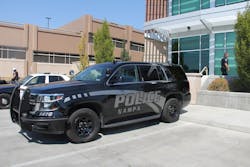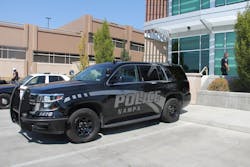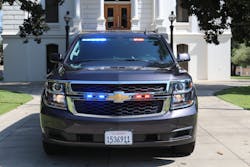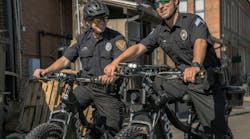There are times you don’t want your law enforcement patrol vehicle (LEPV) to be seen. There can be a number of reasons for this, from targeted traffic enforcement (where you don’t want to be seen until after you’ve captured your evidence against the perpetrator) to spontaneous surveillance tasks where a marked car will hinder your chances of success. There are also times you’d prefer for your LEPV to be visible—really visible. Of course, no matter how well it’s marked or how brightly its lights flash, there will always be those who say, “I didn’t see you.”
The entire profession has come a long way in the past 50 years when it comes to marking patrol vehicles for visibility and lighting them “undercover” when we need visibility and stealth for certain missions. The ability to “hide” an unmarked car is usually minimized due to the fact that, even unmarked, they are still purchased on the same contracts as the marked cars. As such, they tend to be the same make, model, etc. The color might be different but standard equipment is still standard equipment and eventually the public realizes, “That’s a police vehicle.”
Graphics
For marked LEPVs, graphics are added—to what extent is an agency-by-agency, vehicle-by-vehicle decision. Vehicles assigned to permanent traffic enforcement duty should probably be more visible than vehicles permanently assigned to crime prevention or evidence collection officers. Thanks to today’s technologies you can have reflective markings for low-light visibility that aren’t seen during the day. These “stealth” vehicles have become popular in some venues. If your agency just needs an identifiable vehicle, color scheme and graphics can be combined to make a unique and very visible/recognizable LEPV. When you’re selecting and designing your LEPV markings though, try to avoid that door seal centered on the front doors of the vehicle.
A number of decades ago, the California Highway Patrol performed a study that showed how many officers were shot while sitting inside their vehicle and the bullets traveled through the door, through the door seal. It was determined, as supported by the majority of the data, that the door seal is essentially a target with an officer sitting on the other side of it. Be more creative than that. If you must incorporate that door seal (because some chiefs, sheriffs or politicians absolutely demand it), then move it up under the A pillar as much as possible or put it somewhere on the rear quarter panel. Get it off the front door and incorporate it into the overall graphic scheme in some other way.
Lighting
For unmarked vehicles the visibility depends almost entirely on lighting and we do our best to hide that so that it’s only visible while it’s turned on. If your agency is pursuing or has secured CALEA (Commission on Accreditation of Law Enforcement Agencies) accreditation then you need to carefully read their standards for vehicle lighting and marking. If you’re simply interested in making sure your agency’s vehicles are properly marked and equipped for the safety of your officers then it’s a bit easier— just make sure the vehicles can be seen.
It sounds simple, but if you ask any fleet manager you’ll get a wide variety of answers of what’s actually required to have a vehicle be “properly visible.” Let’s start with unmarked cars. Lighting needs to be visible on every side of the vehicle. Certainly the manufacturer’s standard marking lights and flashers help, but they’re a far cry from sufficient for emergency purposes. With the advent of bright LED lights and programmable digital flashing circuitry, it’s relatively simple to mount lights at the top of the windshield, the top of the rear window and on either side immediately behind the B pillar. If you want additional lighting and you have a SUV, putting another light on each side behind the C pillar helps. In addition to the auxiliary lights that are installed, the reverse lights and headlights can both be equipped with flasher units. Additional LEDs can be inserted into the various marker lights if you want extra flash rates or simply more lights for the additional visibility.As to lighting a marked car, many agencies are moving away from rooftop lights and going with thin light bars at the top of the windshield and top edge of the back window. Lights on the side are still mandatory, so those behind-the-B-pillar lights are necessary unless you’re using an actual lightbar on the roof that has 360° visibility. There is also the option of mounting lights on the backside of your side view mirrors.
Something to consider and make sure you address: When the LEPV is sitting on a roadside with the trunk open, can drivers approaching from the rear see the emergency lights? Or are they hidden by the open trunk lid? This was a problem with the Ford Crown Victoria in the mid-1990s. Many agencies addressed the challenge by either mounting lights on the rear deck inside the back window or they mounted a light inside the trunk lid itself.
Another additional concern is making sure your emergency lights can be turned on/off dependent on circumstance. If your only option is fully activating a rooftop lightbar or turning the whole thing off, you have severely limited your visibility options.
Once you’ve completely designed and outfitted your LEPV, turn it on and take a look at it from every angle. Make sure it actually can be seen all the way around even with doors and trunk lid open. If not, adjust accordingly. Check the paperwork for all the installed lights and do the math. What is the flash rate per minute? How bright are those flashes? It may seem silly, but somewhere, at some point down the line, one of your officers may have to answer questions in court as to how they know that the perpetrator who ran could easily identify the pursuing vehicle as a law enforcement vehicle.





